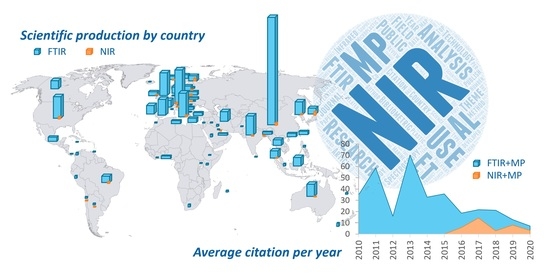Influx of Near-Infrared Technology in Microplastic Community: A Bibliometric Analysis
Abstract
1. Introduction
2. Materials and Methods
2.1. Data Acquisition
- (1)
- (“Plastic Sorting*”) or (“Plastic Waste*”) or (“Plastic Identification”) AND (“Near Infrared*”) or (“NIR*”)
- (2)
- (“Microplastic*”) or (“Microplastics”) AND (“FTIR*”) or (“FT-IR”) or (“Fourier-Transform”)
- (3)
- (“Microplastic*”) or (“Microplastics*”) AND (“Near Infrared*”) or (“NIR*”)
2.2. Bibliometric Analysis
3. Results and Discussion
3.1. General Information
- (1)
- Plastics + NIR
- (2)
- MP + FTIR
- (3)
- MP + NIR
3.2. Annual Publication Output and Citations
3.3. Active Journals
3.4. Distribution by Country
3.5. Quality of Publications
3.6. Co-Occurrence Network: Keyword Analysis
3.7. Thematic Map
- Polyethylene, polypropylene, and polystyrene (Q2, basic theme) are the most studied MP polymer types and this result is consistent with the fact that these polymers account for the majority of plastic waste [59].
- Notably, it can be seen that a theme such as MPs in freshwater and sediments at the edge of Q1 (motor theme) and in Q2 (basic theme) is able to structure the research field. In other words, MPs in the marine environment is the leading topic within the field, probably because MP research has focused on the marine environment from the beginning. In the Q2 region, FTIR with MPs and plastic pollution is seen, and it is clear that in the second quadrant promising and past themes that are part of the research field are found, and FTIR has been used from the beginning of the MP research.
- Between Q1 (motor theme) and Q3 (niche theme) is a cluster of NIR, plastic waste, recycling, polymers, and spectroscopy that is predicted to move into Q1 in the coming years as NIR technology becomes more popular in plastic characterisation.
- According to this analysis, MPs and NIR spectroscopy are identified as emerging topics (Q4), which is the underlying topic of this paper.
- From Q3, it is evident that there are no fully developed themes in the field of MP analysis, neither by FTIR nor NIR methods, and it is well known that there are no standard methods to analyse MPs; however, vibrational spectroscopy-based methods are strongly preferred.
4. Limitations
5. Conclusions
Author Contributions
Funding
Institutional Review Board Statement
Informed Consent Statement
Data Availability Statement
Acknowledgments
Conflicts of Interest
References
- Thompson, R.C.; Olson, Y.; Mitchell, R.P.; Davis, A.; Rowland, S.J.; John, A.W.G.; McGonigle, D.; Russell, A.E. Lost at Sea: Where Is All the Plastic? Science 2004, 304, 838. [Google Scholar] [CrossRef] [PubMed]
- Kershaw, P.J.; Rochman, C.M. Sources, Fate and Effects of Microplastics in the Marine Environment: Part 2 of a Global Assessment. 2015. Available online: https://www.unep.org/resources/report/sources-fate-and-effects-microplastics-marine-environment-global-assessment (accessed on 12 October 2022).
- Li, M.; Wang, Y.; Xue, H.; Wu, L.; Wang, Y.; Wang, C.; Gao, X.; Li, Z.; Zhang, X.; Hasan, M.; et al. Scientometric analysis and scientific trends on microplastics research. Chemosphere 2022, 304, 135337. [Google Scholar] [CrossRef]
- Bank, M.S.; Mitrano, D.M.; Rillig, M.C.; Sze Ki Lin, C.; Ok, Y.S. Embrace complexity to understand microplastic pollution. Nat. Rev. Earth Environ. 2022, 3, 736–737. [Google Scholar] [CrossRef]
- Shim, W.J.; Hong, S.H.; Eo, S.E. Identification methods in microplastic analysis: A review. Anal. Methods 2017, 9, 1384–1391. [Google Scholar] [CrossRef]
- GESAMP Guidelines for the monitoring and assessment of plastic litter in the ocean. GESAMP Reports Stud. 2019, 99, 138.
- Rani, M.; Marchesi, C.; Federici, S.; Rovelli, G.; Alessandri, I.; Vassalini, I.; Ducoli, S.; Borgese, L.; Zacco, A.; Bilo, F.; et al. Miniaturized Near-Infrared (MicroNIR) Spectrometer in Plastic Waste Sorting. Materials 2019, 12, 2740. [Google Scholar] [CrossRef] [PubMed]
- Pakhomova, S.; Zhdanov, I.; van Bavel, B. Polymer type identification of marine plastic litter using a miniature near-infrared spectrometer (Micronir). Appl. Sci. 2020, 10, 8707. [Google Scholar] [CrossRef]
- Marchesi, C.; Rani, M.; Federici, S.; Alessandri, I.; Vassalini, I.; Ducoli, S.; Borgese, L.; Zacco, A.; Núñez-Delgado, A.; Bontempi, E.; et al. Quantification of ternary microplastic mixtures through an ultra-compact near-infrared spectrometer coupled with chemometric tools. Environ. Res. 2023, 216, 114632. [Google Scholar] [CrossRef]
- Karlsson, T.M.; Grahn, H.; Van Bavel, B.; Geladi, P. Hyperspectral imaging and data analysis for detecting and determining plastic contamination in seawater filtrates. J. Near Infrared Spectrosc. 2016, 24, 141–149. [Google Scholar] [CrossRef]
- Abayomi, O.A.; Range, P.; Al-Ghouti, M.A.; Obbard, J.P.; Almeer, S.H.; Ben-Hamadou, R. Microplastics in coastal environments of the Arabian Gulf. Mar. Pollut. Bull. 2017, 124, 181–188. [Google Scholar] [CrossRef]
- Zhang, J.; Tian, K.; Lei, C.; Min, S. Identification and quantification of microplastics in table sea salts using micro-NIR imaging methods. Anal. Methods 2018, 10, 2881–2887. [Google Scholar] [CrossRef]
- McClure, W.F. 204 Years of near infrared technology: 1800-2003. J. Near Infrared Spectrosc. 2003, 11, 487–518. [Google Scholar] [CrossRef]
- Woodcock, T.; Downey, G.; O’Donnell, C.P. Better quality food and beverages: The role of near infrared spectroscopy. J. Near Infrared Spectrosc. 2008, 16, 1–29. [Google Scholar] [CrossRef]
- Shenk, J.S.; Workman, J.J., Jr.; Westerhaus, M.O. Application of NIR spectroscopy to agricultural products. In Handbook of Near-Infrared Analysis; CRC Press: Boca Raton, FL, USA, 2007; pp. 365–404. ISBN 0429123019. [Google Scholar]
- Cleve, E.; Bach, E.; Schollmeyer, E. Using chemometric methods and NIR spectrophotometry in the textile industry. Anal. Chim. Acta 2000, 420, 163–167. [Google Scholar] [CrossRef]
- Blanco, M.; Alcalá, M.; Planells, J.; Mulero, R. Quality control of cosmetic mixtures by NIR spectroscopy. Anal. Bioanal. Chem. 2007, 389, 1577–1583. [Google Scholar] [CrossRef]
- Jamrógiewicz, M. Application of the near-infrared spectroscopy in the pharmaceutical technology. J. Pharm. Biomed. Anal. 2012, 66, 1–10. [Google Scholar] [CrossRef]
- Workman, J. A Brief Review of near Infrared in Petroleum Product Analysis. J. Near Infrared Spectrosc. 1996, 4, 69–74. [Google Scholar] [CrossRef]
- Ferrari, M.; Norris, K.H.; Sowa, M.G. Guest editorial: Medical near infrared spectroscopy 35 years after the discovery. J. Near Infrared Spectrosc. 2012, 20, vii–ix. [Google Scholar] [CrossRef]
- Heigl, N.; Petter, C.H.; Rainer, M.; Najam-ul-Haq, M.; Valiant, R.M.; Bakry, R.; Bonn, G.K.; Huck, C.W. Review: Near infrared spectroscopy for polymer research, quality control and reaction monitoring. J. Near Infrared Spectrosc. 2007, 15, 269–282. [Google Scholar] [CrossRef]
- Huck, C.W. The future role of near infrared spectroscopy in polymer and chemical analysis. NIR News 2016, 27, 17–23. [Google Scholar] [CrossRef]
- Zhou, C.; Bi, R.; Su, C.; Liu, W.; Wang, T. The emerging issue of microplastics in marine environment: A bibliometric analysis from 2004 to 2020. Mar. Pollut. Bull. 2022, 179, 113712. [Google Scholar] [CrossRef] [PubMed]
- Pauna, V.H.; Buonocore, E.; Renzi, M.; Russo, G.F.; Franzese, P.P. The issue of microplastics in marine ecosystems: A bibliometric network analysis. Mar. Pollut. Bull. 2019, 149, 110612. [Google Scholar] [CrossRef]
- Kasavan, S.; Yusoff, S.; Rahmat Fakri, M.F.; Siron, R. Plastic pollution in water ecosystems: A bibliometric analysis from 2000 to 2020. J. Clean. Prod. 2021, 313, 127946. [Google Scholar] [CrossRef]
- Can-Güven, E. Microplastics as emerging atmospheric pollutants: A review and bibliometric analysis. Air Qual. Atmos. Heal. 2021, 14, 203–215. [Google Scholar] [CrossRef]
- Wong, S.L.; Nyakuma, B.B.; Wong, K.Y.; Lee, C.T.; Lee, T.H.; Lee, C.H. Microplastics and nanoplastics in global food webs: A bibliometric analysis (2009–2019). Mar. Pollut. Bull. 2020, 158, 111432. [Google Scholar] [CrossRef] [PubMed]
- Palmas, S.; Vacca, A.; Mais, L. Bibliometric analysis on the papers dedicated to microplastics in wastewater treatments. Catalysts 2021, 11, 913. [Google Scholar] [CrossRef]
- Ebrahimi, P.; Abbasi, S.; Pashaei, R.; Bogusz, A.; Oleszczuk, P. Investigating impact of physicochemical properties of microplastics on human health: A short bibliometric analysis and review. Chemosphere 2022, 289, 133146. [Google Scholar] [CrossRef] [PubMed]
- Lima, P.; Steger, S.; Glade, T.; Murillo-García, F.G. Literature review and bibliometric analysis on data-driven assessment of landslide susceptibility. J. Mt. Sci. 2022, 19, 1670–1698. [Google Scholar] [CrossRef]
- Linnenluecke, M.K.; Marrone, M.; Singh, A.K. Conducting systematic literature reviews and bibliometric analyses. Aust. J. Manag. 2020, 45, 175–194. [Google Scholar] [CrossRef]
- Su, B.; Guan, Q.; Yu, S. The neurotoxicity of nanoparticles: A bibliometric analysis. Toxicol. Ind. Health 2018, 34, 922–929. [Google Scholar] [CrossRef]
- Bragazzi, N.L. Nanomedicine: Insights from a bibliometrics-based analysis of emerging publishing and research trends. Medicina 2019, 55, 785. [Google Scholar] [CrossRef] [PubMed]
- Federici, S.; Ademovic, Z.; Amorim, M.J.B.; Bigalke, M.; Cocca, M.; Depero, L.E.; Dutta, J.; Fritzsche, W.; Hartmann, N.B.; Kalčikova, G.; et al. COST Action PRIORITY: An EU Perspective on Micro- and Nanoplastics as Global Issues. Microplastics 2022, 1, 282–290. [Google Scholar] [CrossRef]
- Veerasingam, S.; Ranjani, M.; Venkatachalapathy, R.; Bagaev, A.; Mukhanov, V.; Litvinyuk, D.; Mugilarasan, M.; Gurumoorthi, K.; Guganathan, L.; Aboobacker, V.M.; et al. Contributions of Fourier transform infrared spectroscopy in microplastic pollution research: A review. Crit. Rev. Environ. Sci. Technol. 2021, 51, 2681–2743. [Google Scholar] [CrossRef]
- SCOPUS. Available online: https://www.scopus.com/ (accessed on 17 August 2022).
- Falagas, M.E.; Pitsouni, E.I.; Malietzis, G.A.; Pappas, G. Comparison of PubMed, Scopus, web of science, and Google scholar: Strengths and weaknesses. FASEB J. 2008, 22, 338–342. [Google Scholar] [CrossRef] [PubMed]
- Aria, M.; Cuccurullo, C. bibliometrix: An R-tool for comprehensive science mapping analysis. J. Informetr. 2017, 11, 959–975. [Google Scholar] [CrossRef]
- Federici, S.; Rani, M.; Depero, L.E. Results of VAMAS Survey Regarding Microplastic Issues. ChemRxiv 2021. preprint. [Google Scholar] [CrossRef]
- Lusher, A.L.; McHugh, M.; Thompson, R.C. Occurrence of microplastics in the gastrointestinal tract of pelagic and demersal fish from the English Channel. Mar. Pollut. Bull. 2013, 67, 94–99. [Google Scholar] [CrossRef] [PubMed]
- Claessens, M.; De Meester, S.; Van Landuyt, L.; De Clerck, K.; Janssen, C.R. Occurrence and distribution of microplastics in marine sediments along the Belgian coast. Mar. Pollut. Bull. 2011, 62, 2199–2204. [Google Scholar] [CrossRef] [PubMed]
- Browne, M.A.; Galloway, T.S.; Thompson, R.C. Spatial patterns of plastic debris along estuarine shorelines. Environ. Sci. Technol. 2010, 44, 3404–3409. [Google Scholar] [CrossRef]
- Li, J.; Liu, H.; Chen, J.P. Microplastics in freshwater systems: A review on occurrence, environmental effects, and methods for microplastics detection. Water Res. 2018, 137, 362–374. [Google Scholar] [CrossRef] [PubMed]
- Mintenig, S.M.; Int-Veen, I.; Löder, M.G.J.; Primpke, S.; Gerdts, G. Identification of microplastic in effluents of waste water treatment plants using focal plane array-based micro-Fourier-transform infrared imaging. Water Res. 2017, 108, 365–372. [Google Scholar] [CrossRef] [PubMed]
- Vianello, A.; Boldrin, A.; Guerriero, P.; Moschino, V.; Rella, R.; Sturaro, A.; Da Ros, L. Microplastic particles in sediments of Lagoon of Venice, Italy: First observations on occurrence, spatial patterns and identification. Estuar. Coast. Shelf Sci. 2013, 130, 54–61. [Google Scholar] [CrossRef]
- Mohamed Nor, N.H.; Obbard, J.P. Microplastics in Singapore’s coastal mangrove ecosystems. Mar. Pollut. Bull. 2014, 79, 278–283. [Google Scholar] [CrossRef]
- Ziajahromi, S.; Neale, P.A.; Rintoul, L.; Leusch, F.D.L. Wastewater treatment plants as a pathway for microplastics: Development of a new approach to sample wastewater-based microplastics. Water Res. 2017, 112, 93–99. [Google Scholar] [CrossRef] [PubMed]
- Li, J.; Yang, D.; Li, L.; Jabeen, K.; Shi, H. Microplastics in commercial bivalves from China. Environ. Pollut. 2015, 207, 190–195. [Google Scholar] [CrossRef]
- Dris, R.; Gasperi, J.; Mirande, C.; Mandin, C.; Guerrouache, M.; Langlois, V.; Tassin, B. A first overview of textile fibers, including microplastics, in indoor and outdoor environments. Environ. Pollut. 2017, 221, 453–458. [Google Scholar] [CrossRef]
- Corradini, F.; Bartholomeus, H.; Huerta Lwanga, E.; Gertsen, H.; Geissen, V. Predicting soil microplastic concentration using vis-NIR spectroscopy. Sci. Total Environ. 2019, 650, 922–932. [Google Scholar] [CrossRef]
- Paul, A.; Wander, L.; Becker, R.; Goedecke, C.; Braun, U. High-throughput NIR spectroscopic (NIRS) detection of microplastics in soil. Environ. Sci. Pollut. Res. 2019, 26, 7364–7374. [Google Scholar] [CrossRef]
- Ng, W.; Minasny, B.; McBratney, A. Convolutional neural network for soil microplastic contamination screening using infrared spectroscopy. Sci. Total Environ. 2020, 702, 134723. [Google Scholar] [CrossRef]
- Peiponen, K.E.; Räty, J.; Ishaq, U.; Pélisset, S.; Ali, R. Outlook on optical identification of micro- and nanoplastics in aquatic environments. Chemosphere 2019, 214, 424–429. [Google Scholar] [CrossRef]
- Schönlau, C.; Karlsson, T.M.; Rotander, A.; Nilsson, H.; Engwall, M.; van Bavel, B.; Kärrman, A. Microplastics in sea-surface waters surrounding Sweden sampled by manta trawl and in-situ pump. Mar. Pollut. Bull. 2020, 153, 111019. [Google Scholar] [CrossRef]
- Michel, A.P.M.; Morrison, A.E.; Preston, V.L.; Marx, C.T.; Colson, B.C.; White, H.K. Rapid Identification of Marine Plastic Debris via Spectroscopic Techniques and Machine Learning Classifiers. Environ. Sci. Technol. 2020, 54, 10630–10637. [Google Scholar] [CrossRef]
- Zhu, C.; Kanaya, Y.; Nakajima, R.; Tsuchiya, M.; Nomaki, H.; Kitahashi, T.; Fujikura, K. Characterization of microplastics on filter substrates based on hyperspectral imaging: Laboratory assessments. Environ. Pollut. 2020, 263, 114296. [Google Scholar] [CrossRef]
- Pieszczek, L.; Daszykowski, M. Near-infrared hyperspectral imaging for polymer particle size estimation. Measurement 2021, 186, 110201. [Google Scholar] [CrossRef]
- Cobo, M.J.; López-Herrera, A.G.; Herrera-Viedma, E.; Herrera, F. An approach for detecting, quantifying, and visualizing the evolution of a research field: A practical application to the Fuzzy Sets Theory field. J. Informetr. 2011, 5, 146–166. [Google Scholar] [CrossRef]
- Chubarenko, I.; Efimova, I.; Bagaeva, M.; Bagaev, A.; Isachenko, I. On mechanical fragmentation of single-use plastics in the sea swash zone with different types of bottom sediments: Insights from laboratory experiments. Mar. Pollut. Bull. 2020. [Google Scholar] [CrossRef]
- Ferreira, M.P.; Santos, J.C.; de Almeida, M.I.R.; Reis, N.R. Mergers & acquisitions research: A bibliometric study of top strategy and international business journals, 1980–2010. J. Bus. Res. 2014, 67, 2550–2558. [Google Scholar]
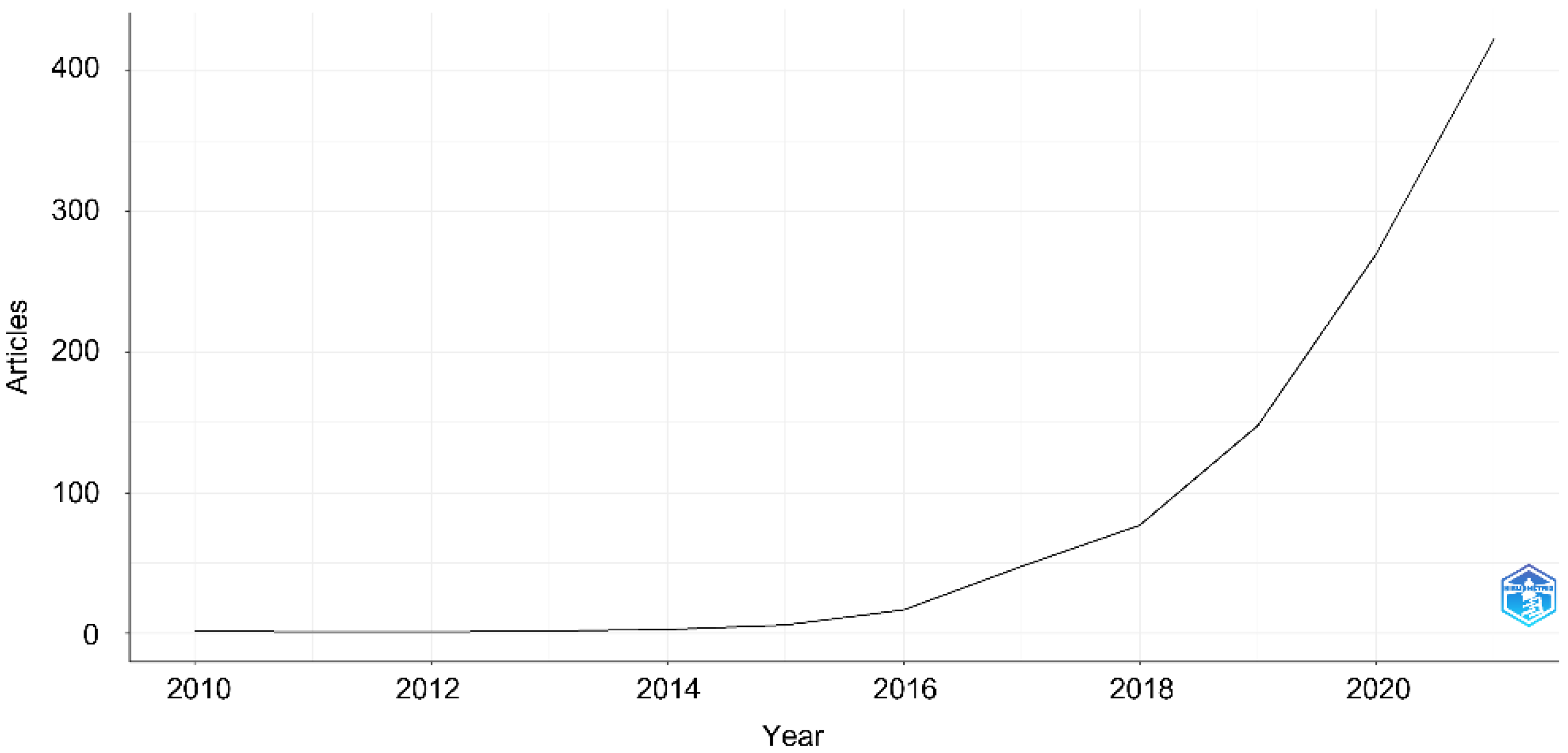

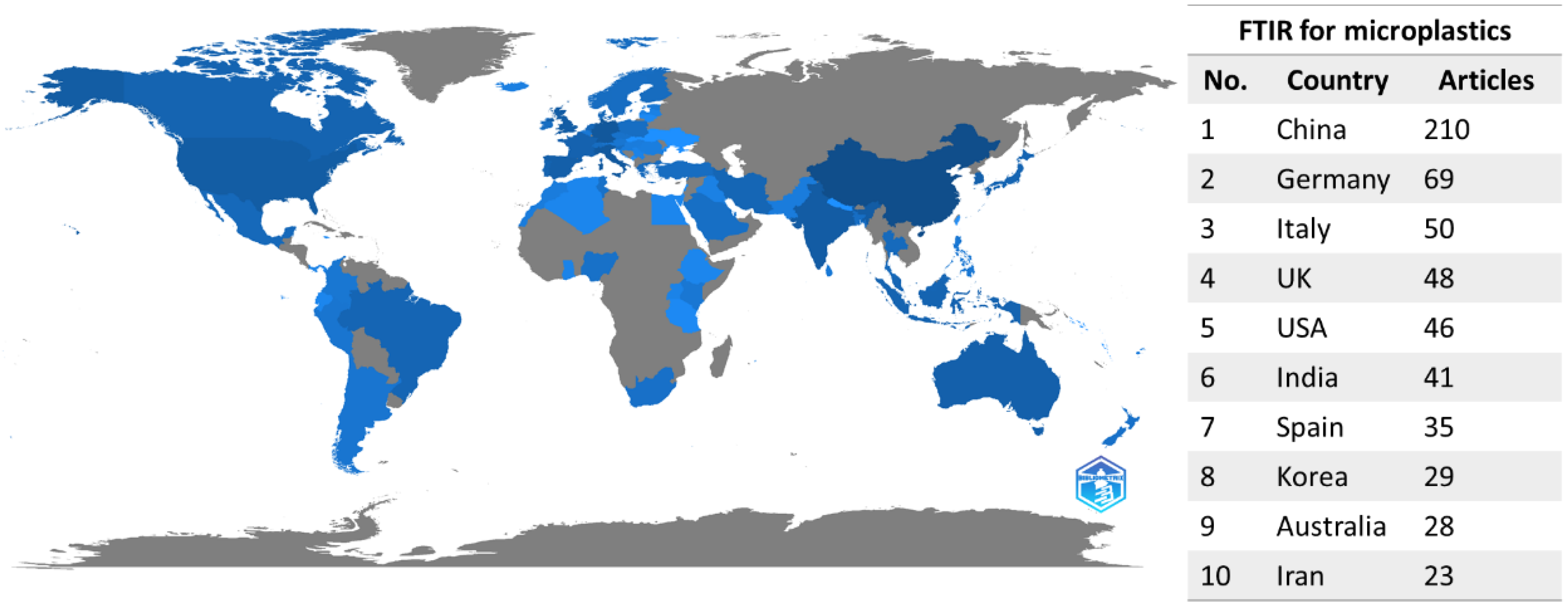
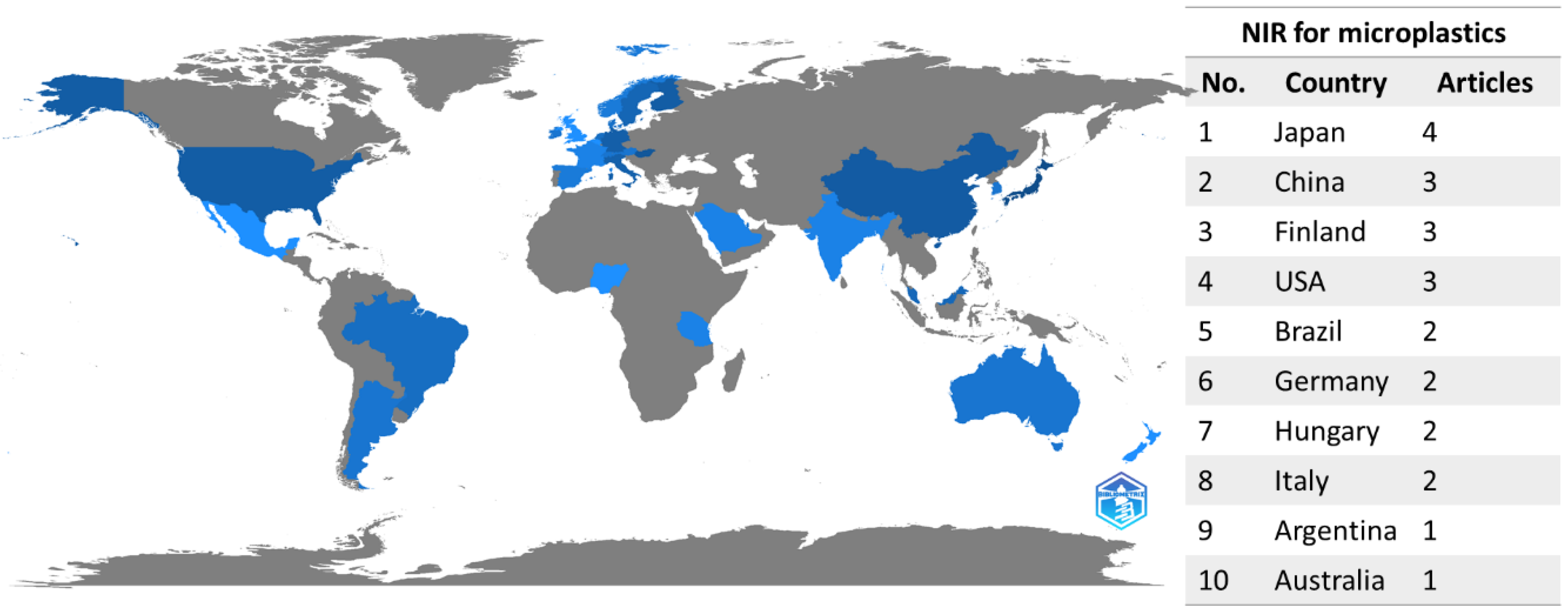
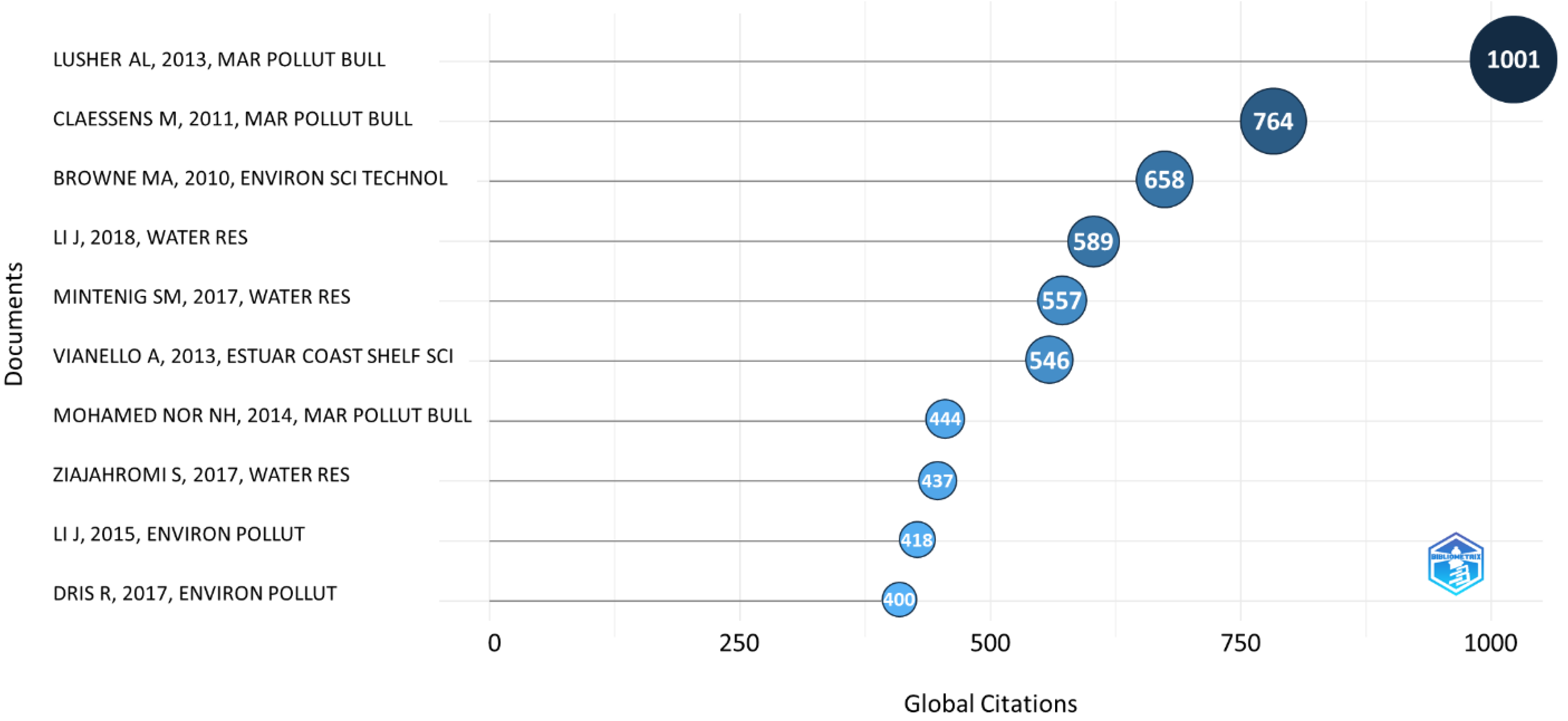
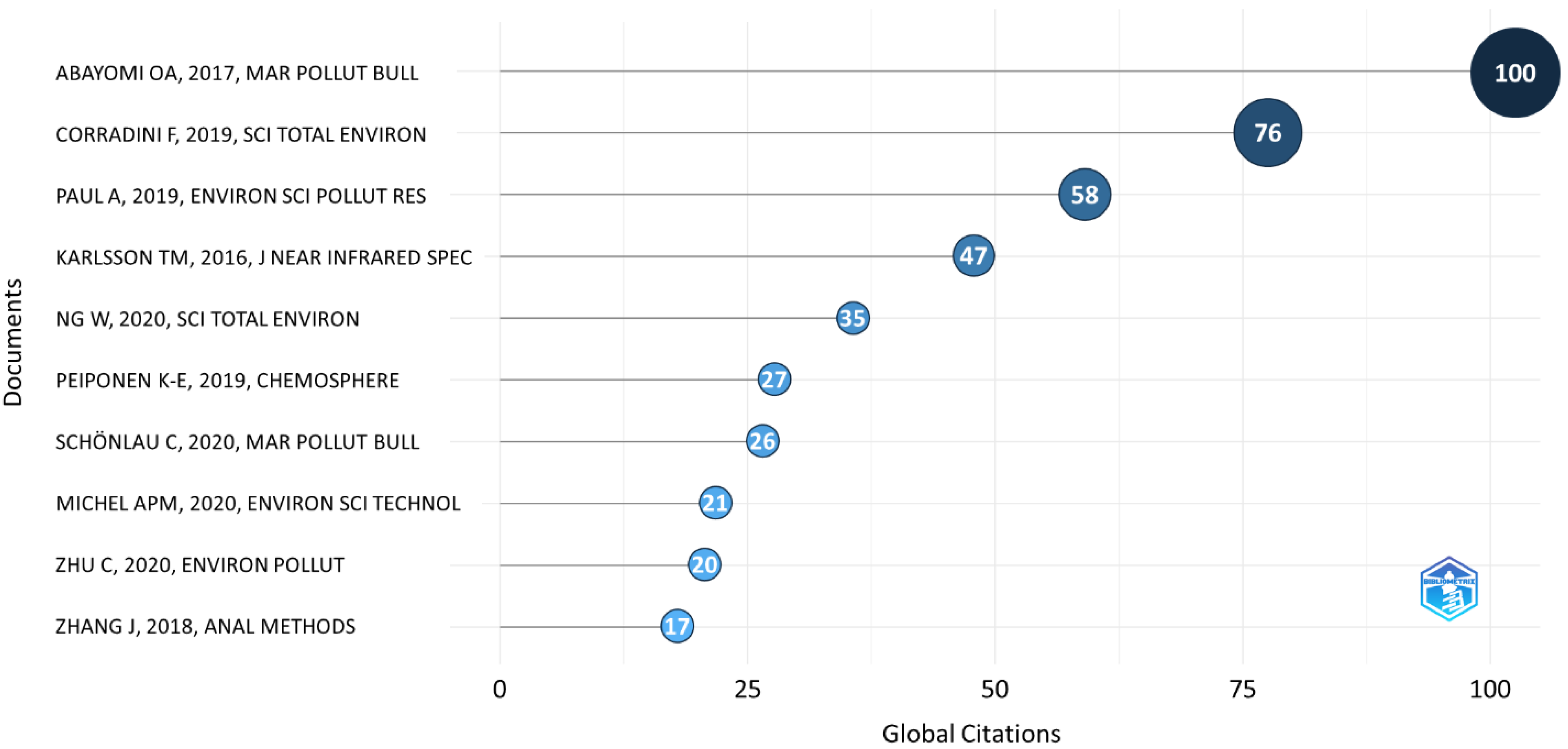
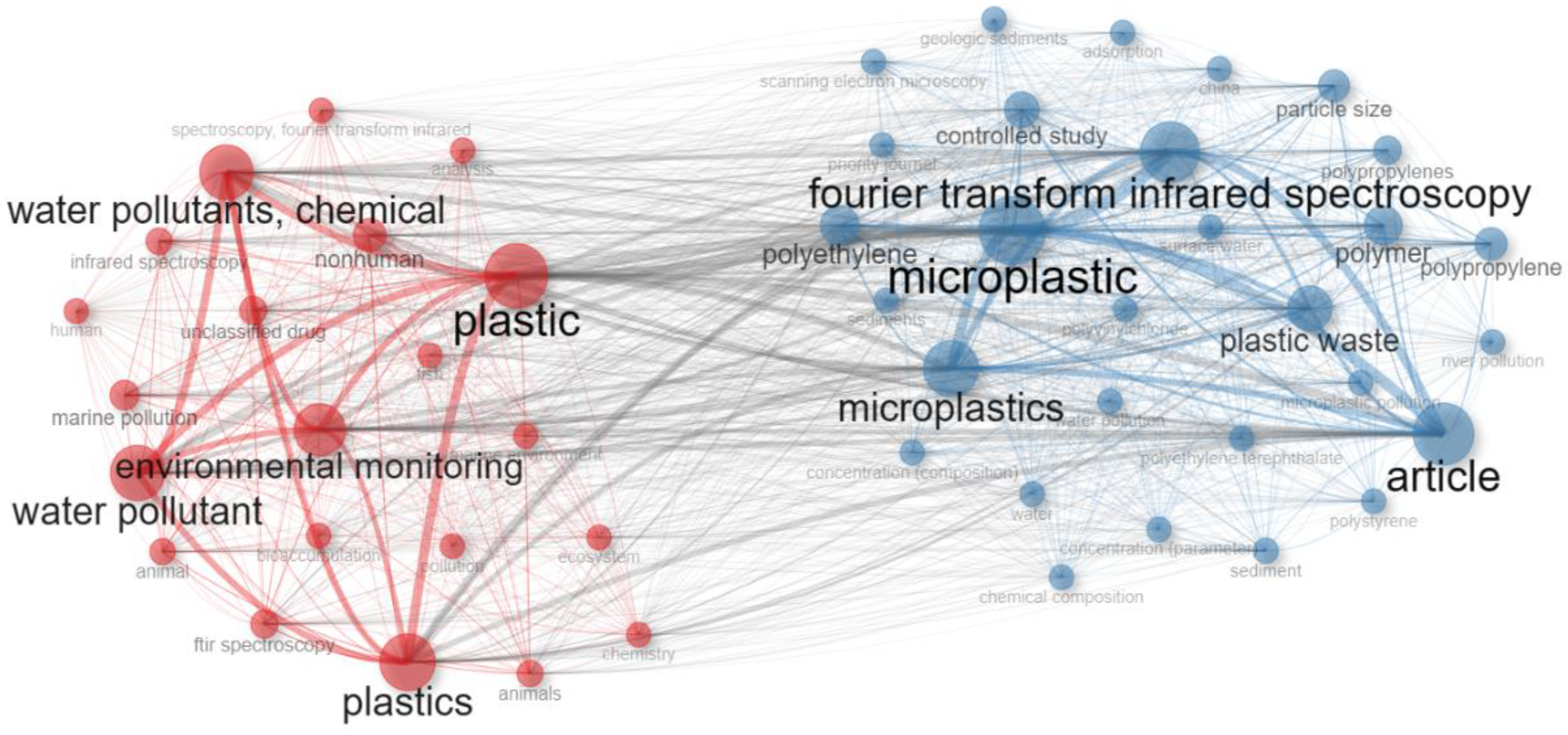
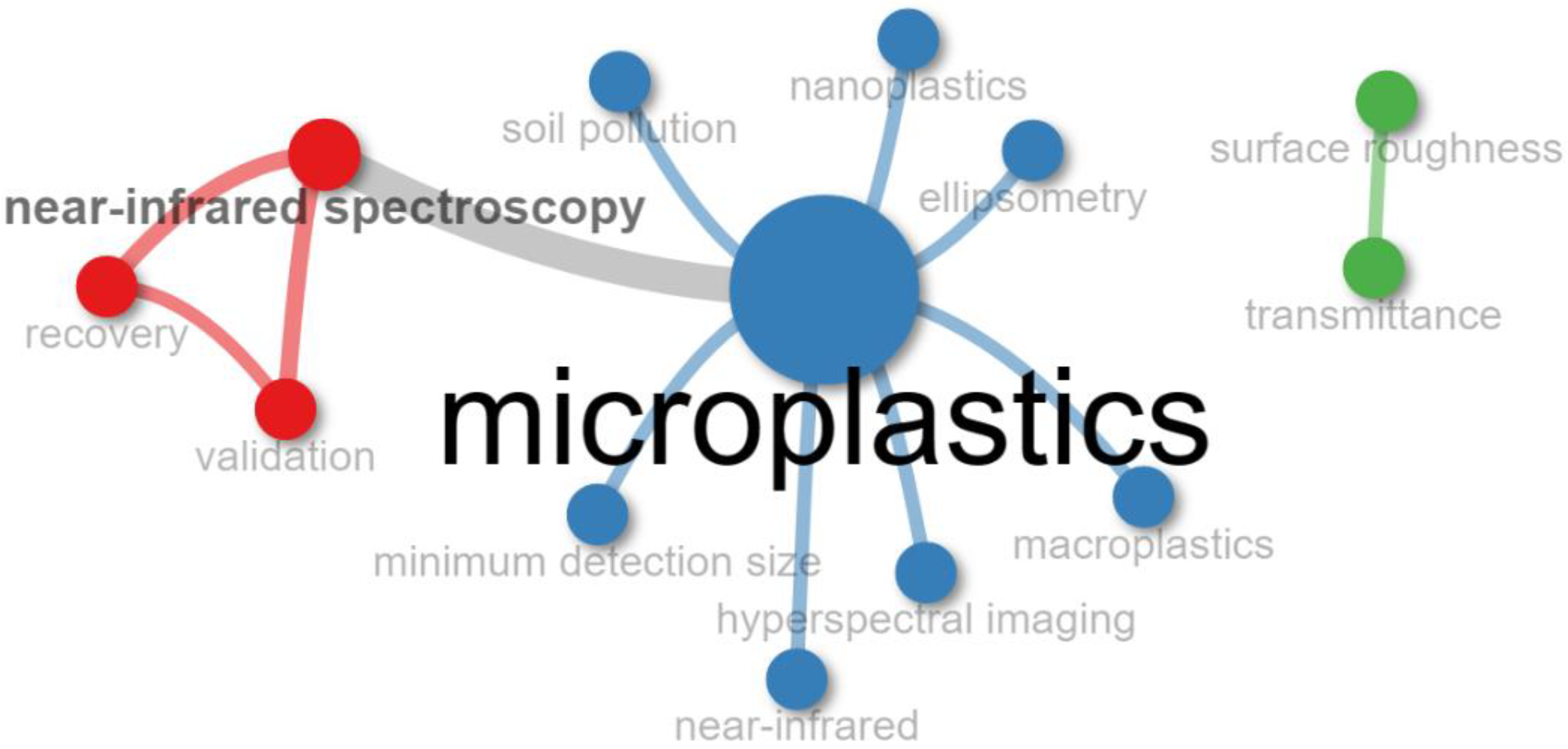


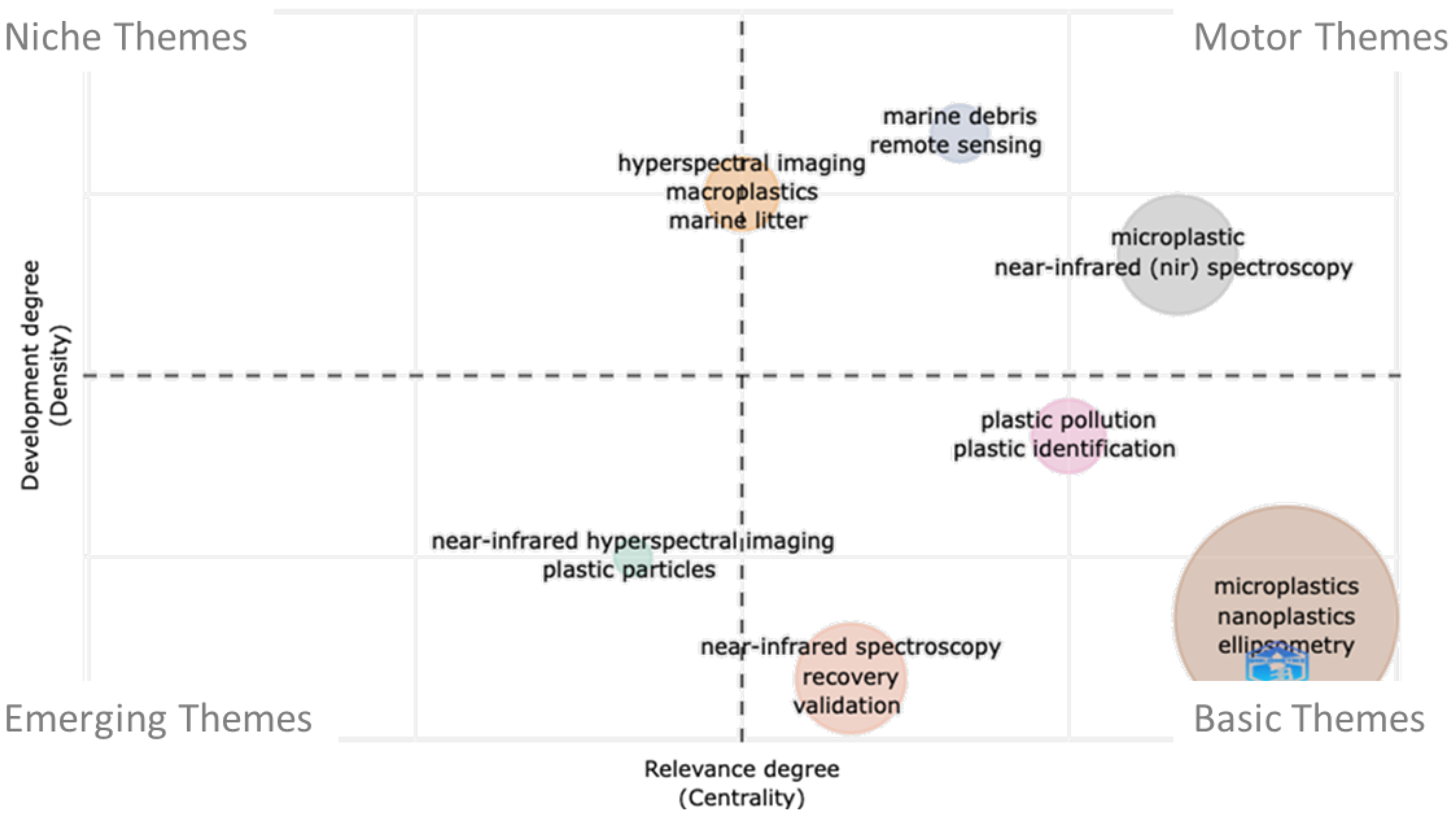
| Description | Results | ||
|---|---|---|---|
| Main information about data | 1. Plastic + NIR | 2. MP + FTIR | 3. MP+ NIR |
| Timespan | 1993:2021 | 2010:2021 | 2016:2021 |
| Source (Journals, book, etc.) | 67 | 174 | 25 |
| Documents | 102 | 998 | 39 |
| Average years from publication | 6.7 | 2.19 | 1.79 |
| Average citation per document | 16.16 | 46.51 | 14.18 |
| Average citations per year doc | 2.703 | 10.78 | 4.044 |
| Document Type | |||
| Article | 68 | 919 | 35 |
| Conference Paper | 25 | 25 | 02 |
| Review | 09 | 54 | 02 |
| Year | FTIR + MP Number of Publications | FTIR + MP Average Citation per Year | NIR + MP Number of Publications | NIR + MP Average Citation per Year |
|---|---|---|---|---|
| 2010 | 2 | 34.89 | - | - |
| 2011 | 1 | 58.77 | - | - |
| 2012 | 1 | 15.83 | - | - |
| 2013 | 2 | 70.32 | - | - |
| 2014 | 3 | 32.77 | - | - |
| 2015 | 6 | 35.7 | - | - |
| 2016 | 17 | 18.57 | 1 | 5.88 |
| 2017 | 48 | 21.73 | 1 | 14.29 |
| 2018 | 77 | 21.23 | 1 | 2.83 |
| 2019 | 148 | 12.73 | 4 | 8.05 |
| 2020 | 270 | 7.12 | 11 | 3.18 |
| 2021 | 423 | 2.58 | 21 | 1.40 |
| FTIR + MP | Journal IF 2021 | NIR + MP | Journal IF 2021 |
|---|---|---|---|
| Marine Pollution Bulletin | 7.001 | Marine Pollution Bulletin | 7.001 |
| Science of the Total Environment | 10.753 | Analytical Methods | 3.532 |
| Environmental Pollution | 9.988 | Chemosphere | 8.943 |
| Chemosphere | 8.943 | Environmental Pollution | 9.988 |
| Journal of Hazardous Materials | 14.224 | Science of the Total Environment | 10.753 |
| Water Research | 13.400 | Journal of Hazardous Materials | 14.224 |
| Environmental Science and Technology | 11.357 | Water Research | 13.400 |
| Environmental Science and Pollution Research | 5.190 | ACS Applied Materials and Interfaces | 10.383 |
| MethodsX | 2.21 | Applied Sciences (Switzerland) | 2.838 |
| Environmental Toxicology and Chemistry | 4.218 | Chemosensors | 4.229 |
Disclaimer/Publisher’s Note: The statements, opinions and data contained in all publications are solely those of the individual author(s) and contributor(s) and not of MDPI and/or the editor(s). MDPI and/or the editor(s) disclaim responsibility for any injury to people or property resulting from any ideas, methods, instructions or products referred to in the content. |
© 2023 by the authors. Licensee MDPI, Basel, Switzerland. This article is an open access article distributed under the terms and conditions of the Creative Commons Attribution (CC BY) license (https://creativecommons.org/licenses/by/4.0/).
Share and Cite
Rani, M.; Ducoli, S.; Federici, S.; Depero, L.E. Influx of Near-Infrared Technology in Microplastic Community: A Bibliometric Analysis. Microplastics 2023, 2, 107-121. https://doi.org/10.3390/microplastics2010008
Rani M, Ducoli S, Federici S, Depero LE. Influx of Near-Infrared Technology in Microplastic Community: A Bibliometric Analysis. Microplastics. 2023; 2(1):107-121. https://doi.org/10.3390/microplastics2010008
Chicago/Turabian StyleRani, Monika, Serena Ducoli, Stefania Federici, and Laura Eleonora Depero. 2023. "Influx of Near-Infrared Technology in Microplastic Community: A Bibliometric Analysis" Microplastics 2, no. 1: 107-121. https://doi.org/10.3390/microplastics2010008
APA StyleRani, M., Ducoli, S., Federici, S., & Depero, L. E. (2023). Influx of Near-Infrared Technology in Microplastic Community: A Bibliometric Analysis. Microplastics, 2(1), 107-121. https://doi.org/10.3390/microplastics2010008






